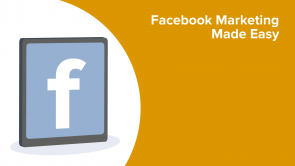Facebook Case Studies

About the Lecture
The lecture Facebook Case Studies by Ben Hunt is from the course Facebook Marketing Made Easy (EN). It contains the following chapters:
- Introduction to the 5 Case Studies
- Case Study 1
- Basics of Facebook Engagement
- Case Study 2
- Case Study 3
- Case Study 4
- Case Study 5
- Summary
Included Quiz Questions
How can you bring people to like your Facebook page?
- Use a call to action (“Like our Facebook page”, “Have a look at this”).
- Explain why they should like it and which benefit they gain by liking it while appealing to the self-interest.
- Do not use a call to action.
- Explain your goods or services.
What are the basics of Facebook engagement?
- Build true page likes (=reach).
- Build engagement (post likes, comments, shares), which in turn support your reach.
- Give reasons and opportunities to buy (calls to action).
- Build true and false page likes.
- Likes are the key.
When your client is selling many different products, what would be the best way to present these products on Facebook?
- The best way to present the products would be by selecting some particular items, taking good-quality photos and highlighting these items.
- The best way to present the products would be by creating a folder and uploading photos of all the items into it.
- The best way to present the products would be by selecting one particular item, taking a photo and highlighting it.
- There is no way to present the products in the best way.
When you notice that a business might not be working for you, what should you do?
- Go through the 8-point checklist and if only a few points apply, walk away and stop working for that business.
- Go through the 6-point checklist and if only a few points apply, walk away and stop working for that business.
- Go through the 8-point checklist and if not all the points apply, walk away and stop working for that business.
- Go through the 8-point checklist and even if not all the points apply, do not give up.
What is the difference between organic and paid reach?
- Organic reach is the total number of unique people who were shown your post through unpaid distribution. Paid reach is the total number of unique people who were shown your post as a result of ads.
- Paid reach is the total number of unique people who were shown your post through unpaid distribution. Organic reach is the total number of unique people who were shown your post as a result of ads.
- There is no difference.
- Paid reach addresses only people in your area, while organic reach addresses people all over the world.
Why does LED Trade Counter have only 38 fans on Facebook?
- LED lights are not frequently bought and the products do not stand out in the marketplace.
- It does not fit with the Facebook mode.
- The market is not coherent.
- The market is not large.
- It is not profitable.
What is the key to find ideal clients?
- It is to disregard the wrong clients as quickly as possible.
- It is to disregard the right clients as quickly as possible.
- It is to regard the right clients as quickly as possible.
- It is to find any clients at all as quickly as possible.
What is the single most important key to success as a Facebook marketing consultant?
- It is finding ideal clients.
- It is finding potential clients.
- It is finding wrong clients.
- It is finding the right strategies for ads.
These courses may be of interest to you
Customer reviews
5,0 of 5 stars
| 5 Stars |
|
5 |
| 4 Stars |
|
0 |
| 3 Stars |
|
0 |
| 2 Stars |
|
0 |
| 1 Star |
|
0 |



